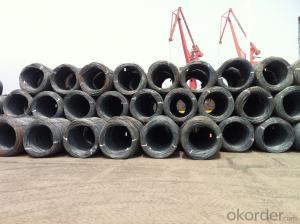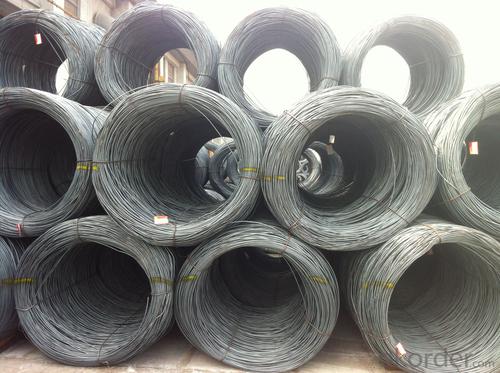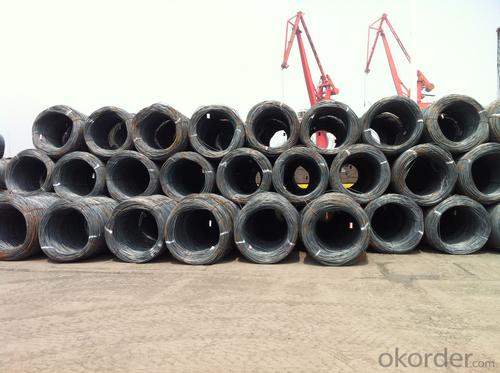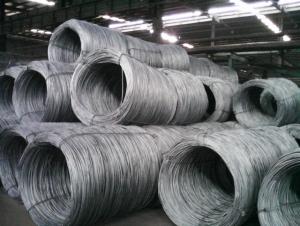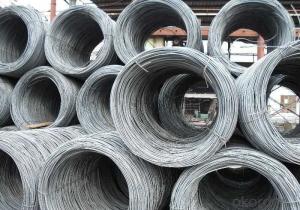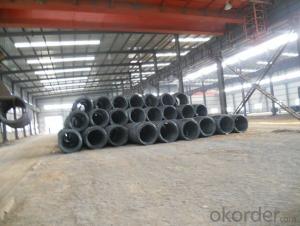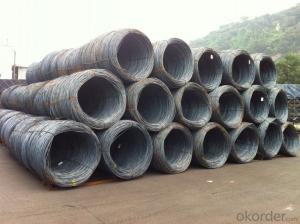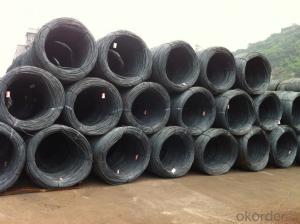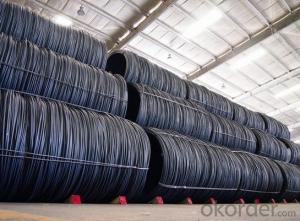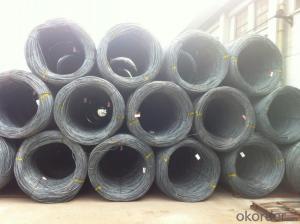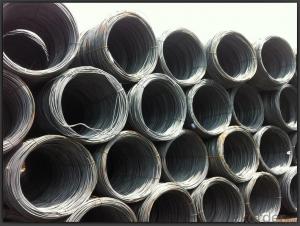Hot Rolled Wire rods in Grade SAE1008 with Best Price
- Loading Port:
- Tianjin
- Payment Terms:
- TT OR LC
- Min Order Qty:
- 25 m.t
- Supply Capability:
- 20000 m.t/month
OKorder Service Pledge
OKorder Financial Service
You Might Also Like
OKorder is offering Carbon Steel Wire Rod at great prices with worldwide shipping. Our supplier is a world-class manufacturer of steel, with our products utilized the world over. OKorder annually supplies products to European, North American and Asian markets. We provide quotations within 24 hours of receiving an inquiry and guarantee competitive prices.
Product Applications:
After hot-rolled the products shaped into coil and delivery as finished product, including round, square, rectangular, hexagonal and so on. Since most of the products are round, it is generally called wire rod. Carbon steel wire rod is widely used in construction and manufacturing. Carbon steel wire rod is mainly used for reinforcement of reinforced concrete and welded structure or reprocessed (roberts , nail, etc.) materials, especially used to produce wire drawing, welding electrode, nails, spring, electronic, precise machinery parts and so on.
Product Advantages:
OKorder's Carbon Steel Wire Rod are durable, strong, and resist corrosion.
Main Product Features:
· Premium quality
· Corrosion resistance
· Mill test certification
· Professional Service
· Competitive pricing
Product Specifications:
Chemical Composition:
Please kindly find our chemistry of our material based on SAE1006/SAE1008 as below for your information
Grade | Chemical Composition (%) | |||||
C | Mn | S | P | Si | B | |
SAE1006 | 0.03~O.07 | 0.32max | 0.045max | 0.040max | 0.30max | 0.0008min |
Mechanical properties | ||||||
Yield strength(N/mm2) | Tensile strength(N/mm2) | Elongation (%) | ||||
250-280 | 350-380 | ≥32 | ||||
Grade | Chemical Composition (%) | |||||
C | Mn | S | P | Si | B | |
SAE1008 | 0.10max | 0.3~0.50 | 0.050max | 0.040 max | 0.15max | 0.0008 min |
Mechanical properties | ||||||
Yield strength(N/mm2) | Tensile strength(N/mm2) | Elongation (%) | ||||
≥195 | 315-430 | ≥30 | ||||
FAQ:
Q1: How do we guarantee the quality of our products?
A1: We have established an advanced quality management system which conducts strict quality tests at every step, from raw materials to the final product. At the same time, we provide extensive follow-up service assurances as required.
Q2: What's your payment terms ?
A2: Usually,we collect the money by T/T and LC at sight .We also accept LC at 90/120/180 days .
Q3: How soon we can delivery the goods ?
A3: We have a mill with 20000mts of capacity per month. We can delivery the goods within one month.
Image:
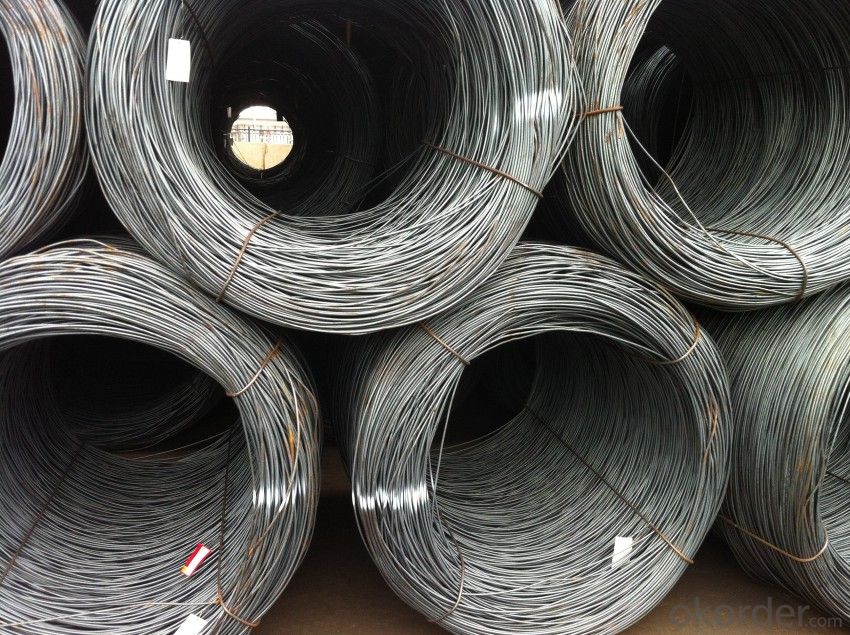
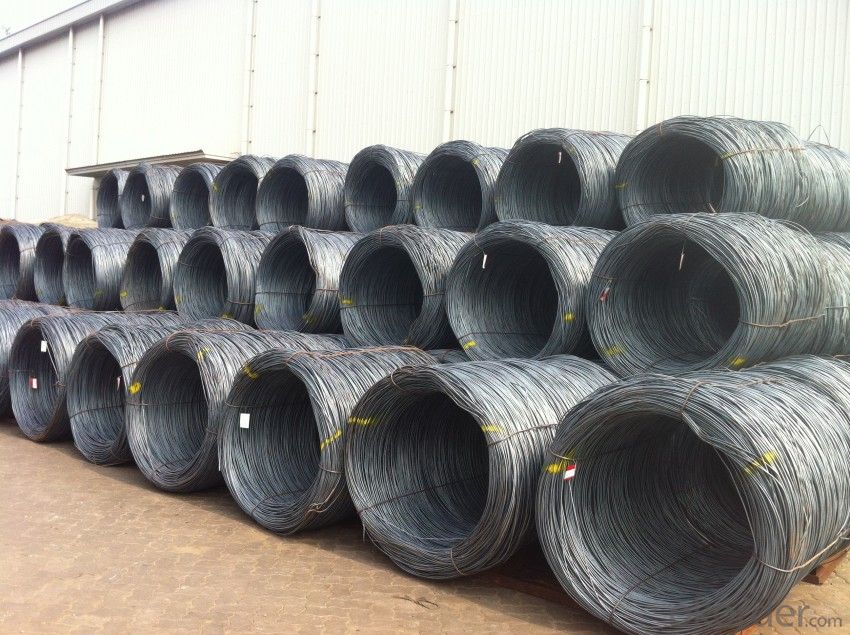
- Q: What are the main factors affecting the market advocacy of steel wire rod?
- The main factors affecting the market advocacy of steel wire rod include demand and supply dynamics, price fluctuations in raw materials, global economic conditions, technological advancements, government regulations and policies, competition from alternative materials, and customer preferences for quality and cost-effectiveness.
- Q: What are the common applications of pre-stressed concrete steel wire rod?
- Pre-stressed concrete steel wire rods are commonly used in various construction applications such as bridges, dams, parking structures, and high-rise buildings. They are used to reinforce and strengthen concrete structures, increasing their load-carrying capacity and durability. Additionally, pre-stressed concrete steel wire rods are also utilized in the construction of railway sleepers, poles, and other infrastructure projects.
- Q: How is steel wire rod used in the manufacturing of wire forms for lighting fixtures?
- Steel wire rod is used in the manufacturing of wire forms for lighting fixtures as it serves as the primary raw material for creating various wire shapes and designs. The wire rod provides the necessary strength, durability, and malleability required for bending, twisting, and shaping the wire into the desired form. It is commonly used to create intricate structures such as lampshades, frames, and decorative elements, ensuring that the lighting fixtures are sturdy and aesthetically pleasing.
- Q: What are the common handling methods for steel wire rod?
- The common handling methods for steel wire rod include using cranes or forklifts to lift and transport the rods, storing them in racks or on pallets, and using wire rod coils or spools for easier handling and transportation.
- Q: How is steel wire rod used in the manufacturing of staples?
- Staples manufacturing heavily relies on steel wire rods, which are indispensable components. These wire rods are typically made from top-notch steel and are available in a range of diameters. The staple manufacturing process initiates by coiling the steel wire rods and then drawing them through a set of dies to reduce their diameter and increase their length. This drawing process not only enhances the wire's strength but also ensures its uniformity. Once the desired wire diameter is achieved, the steel wire is cut into smaller lengths, determining the size of the produced staples. These wire lengths are then introduced into a specialized staple manufacturing machine, where they undergo a series of operations. To begin with, the wire is fed into a machine that straightens and cleans it, eliminating any impurities or irregularities. Afterward, the straightened wire is cut and shaped into individual staple blanks. These blanks undergo further processing through a combination of bending, cutting, and shaping operations to form the characteristic "U" shape of the staple legs. Following that, the legs of the staples are bent inward or clinched to create the necessary tension for securely holding papers or other materials together. Typically, this process is executed using a clinching machine, which exerts the required force to bend the legs inward and create the final staple shape. Lastly, the manufactured staples go through a rigorous quality control check to ensure compliance with the required standards in terms of dimensions, strength, and overall quality. This evaluation may include checking for proper leg length, shape uniformity, and testing the staples' ability to securely hold materials. In essence, steel wire rods play a pivotal role in the staple manufacturing process, providing high-strength material necessary for securely fastening papers or other materials. Through a series of intricate processes, the wire rods are transformed into the iconic "U" shape of staples, guaranteeing their functionality and dependability for various applications.
- Q: What are the main factors influencing the choice of steel wire rod packaging materials?
- The main factors influencing the choice of steel wire rod packaging materials can vary depending on various factors. However, some of the key factors include: 1. Product characteristics: The characteristics of the steel wire rod, such as its size, shape, weight, and fragility, play a crucial role in determining the appropriate packaging material. For instance, if the wire rod is heavy or has sharp edges, it may require stronger packaging materials like steel crates or wooden pallets to ensure safe transportation. 2. Transportation and handling requirements: The mode of transportation, distance, and handling conditions also influence the choice of packaging materials. If the wire rods are being transported over long distances or via rough terrain, more durable and robust packaging materials may be needed to protect the product from damage or breakage. 3. Environmental factors: Environmental conditions, such as temperature, humidity, and exposure to moisture or corrosive substances, can impact the choice of packaging materials. For instance, if the wire rods are being stored or transported in humid environments, packaging materials that offer moisture resistance, such as plastic or coated materials, may be preferred. 4. Cost-effectiveness: The cost of packaging materials is another important factor to consider. Companies need to evaluate the cost-effectiveness of different packaging options, taking into account factors such as material cost, durability, and potential for reuse or recycling. Balancing cost with the necessary level of protection is essential to ensure profitability. 5. Regulatory compliance: Compliance with industry regulations and standards is crucial in choosing the packaging materials. Certain industries or regions may have specific requirements for packaging materials, such as fire-resistant properties, eco-friendly materials, or certifications like ISO standards. Adhering to these regulations is essential for legal and ethical reasons. 6. Customer expectations: Customer preferences and expectations also play a role in determining the choice of packaging materials. For example, if customers value sustainability and eco-friendly packaging, companies may opt for recyclable or biodegradable materials to align with their customers' values. In conclusion, the choice of steel wire rod packaging materials is influenced by several factors, including product characteristics, transportation requirements, environmental factors, cost-effectiveness, regulatory compliance, and customer expectations. Companies need to carefully evaluate these factors to select the most appropriate packaging materials that ensure the safe transportation and delivery of the wire rods while meeting customer demands and regulatory requirements.
- Q: How is steel wire rod used in the manufacturing of fences?
- Steel wire rod is commonly used in the manufacturing of fences as it serves as the primary material for creating the structural framework. The wire rod is typically shaped and welded to form the fence's posts, rails, and crossbars, providing strength, stability, and durability to the overall structure. It is also used to create the intricate patterns or mesh designs, securing the fence and ensuring its effectiveness in providing security or defining boundaries.
- Q: How is steel wire rod inspected for dimensional accuracy?
- Steel wire rod is inspected for dimensional accuracy using various methods and tools. One of the common methods is the use of a caliper or micrometer to measure the diameter of the wire rod at different points along its length. This ensures that the wire rod meets the required specifications in terms of diameter. Another important aspect of dimensional accuracy is the roundness of the wire rod. To inspect roundness, a roundness tester is used, which measures the deviation of the wire rod from a perfect circle. This helps to ensure that the wire rod is uniform and free from any irregularities. In addition to diameter and roundness, the straightness of the wire rod is also inspected. This is done by placing the wire rod on a surface plate or straight edge and visually inspecting for any deviations from a straight line. Any bends or twists in the wire rod can affect its performance and suitability for various applications, so it is crucial to ensure its straightness. Furthermore, the surface quality of the wire rod is also inspected. This involves visual inspection for any surface defects such as scratches, pits, or any other irregularities that may affect the wire rod's performance or appearance. Overall, the dimensional accuracy of steel wire rod is inspected using a combination of measurement tools, visual inspection, and specialized testing equipment. This ensures that the wire rod meets the required specifications and is suitable for its intended use.
- Q: What are the factors that influence the mechanical properties of steel wire rod?
- There are several factors that can influence the mechanical properties of steel wire rods. These factors include: 1. Composition: The chemical composition of the steel, including the presence of alloying elements, plays a significant role in determining its mechanical properties. Elements such as carbon, manganese, silicon, and others can affect the strength, hardness, and ductility of the wire rod. 2. Microstructure: The microstructure of the steel, which is determined by factors such as cooling rate and heat treatment, can greatly influence its mechanical properties. The arrangement of grains, the presence of impurities, and the size and distribution of precipitates can all affect the wire rod's strength, toughness, and other properties. 3. Processing conditions: The processing conditions during the production of wire rods, such as the temperature, cooling rate, and rolling conditions, can have a significant impact on the mechanical properties. For example, controlled cooling rates can result in a fine-grained microstructure, which can enhance the wire rod's strength and toughness. 4. Heat treatment: Heat treatment processes such as annealing, quenching, and tempering can be used to further modify the mechanical properties of steel wire rods. These processes can help to refine the microstructure, relieve internal stresses, and improve the wire rod's strength, hardness, and ductility. 5. Surface finish: The surface finish of the wire rod, including factors such as scale, decarburization, and surface defects, can also affect its mechanical properties. A smooth and clean surface can contribute to better fatigue resistance and overall mechanical performance. 6. Size and shape: The size and shape of the wire rod, including its diameter and cross-sectional profile, can influence its mechanical properties. Thicker rods tend to have higher strength but lower ductility, while thinner rods may exhibit higher ductility but lower strength. 7. Environmental conditions: The mechanical properties of steel wire rods can also be influenced by the environmental conditions in which they are used. Factors such as temperature, humidity, and exposure to corrosive substances can all impact the wire rod's strength, toughness, and corrosion resistance. It is important to consider these factors when selecting or designing steel wire rods for specific applications, as they can greatly impact the performance and reliability of the final product.
- Q: How does the ductility of steel wire rod vary with different wire drawing processes?
- The ductility of steel wire rod can change depending on the wire drawing technique utilized. Wire drawing, a metalworking process in which a metal wire is pulled through a die to decrease its diameter and increase its length, is responsible for this variation. The ductility of the steel wire rod refers to its capacity to deform under tensile stress without fracturing. The ductility of the steel wire rod can be influenced by different wire drawing techniques due to several factors, including the degree of diameter reduction, the number of drawing passes, and the temperature employed during the process. Generally, as the wire's diameter decreases during wire drawing, the ductility of the steel wire rod increases. This is because reducing the diameter raises the dislocation density in the steel's crystal lattice, allowing for greater plastic deformation before fracture occurs. The number of drawing passes also has an impact on the ductility of the steel wire rod. Multiple drawing passes permit a more controlled reduction in diameter, resulting in a more even distribution of dislocations and an increase in ductility. Moreover, the temperature during the wire drawing process can affect the ductility of the steel wire rod. Higher temperatures can enhance ductility by reducing the steel's strength, allowing for more deformation before fracture. Nevertheless, excessive heat can have a negative impact on the steel's microstructure and reduce its ductility. To sum up, the ductility of steel wire rod can differ depending on the wire drawing technique employed. Factors such as the degree of diameter reduction, the number of drawing passes, and the temperature during the process all contribute to determining the final ductility of the wire.
Send your message to us
Hot Rolled Wire rods in Grade SAE1008 with Best Price
- Loading Port:
- Tianjin
- Payment Terms:
- TT OR LC
- Min Order Qty:
- 25 m.t
- Supply Capability:
- 20000 m.t/month
OKorder Service Pledge
OKorder Financial Service
Similar products
Hot products
Hot Searches
Related keywords

